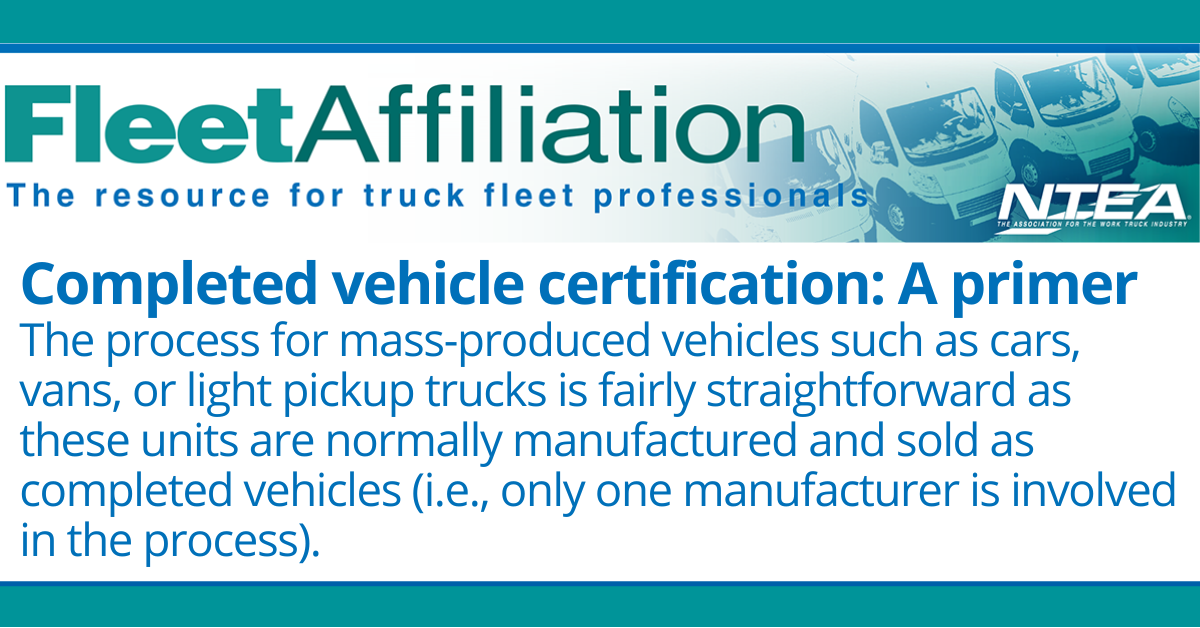
Published in November 2022 Fleet Affiliation.
Most fleet professionals are aware that vehicles must be certified before they can be licensed; however, it is important to understand what it means to certify – and this includes which parties are responsible for various tasks.
Before any vehicle can be sold in the U.S., the final manufacturer must certify that it conforms to all applicable Federal Motor Vehicle Safety Standards (FMVSS). Correspondingly, Canada has very similar requirements outlined in the Canadian Motor Vehicle Safety Standards (CMVSS).
The process for mass-produced vehicles such as cars, vans, or light pickup trucks is fairly straightforward as these units are normally manufactured and sold as a completed vehicles (i.e., only one manufacturer is involved in the process).
On the other hand, the process is more involved for the work truck and vocation-specific industry, as these vehicles may leave the oem as an incomplete vehicle as it starts the upfitting journey. The vast nature of vehicle sourcing can complicate the certification process. There are various stages in which vehicles are certified — incomplete, intermediate, final, and altered — so it’s important that fleet professionals are aware of the differences. The manufacturer or upfitter who completes the vehicle to the point where it can be licensed is considered to be the final stage manufacturer.
Certification is complex. Who is responsible and when does it end?
There are two certification scenarios often seen by fleets: final-stage and altered. Final-stage certification includes a unit that started as an incomplete vehicle before undergoing one or more additional manufacturing stages to be completed. Final-stage manufacturers are responsible for ensuring compliance of the vehicles they complete.
Altered-stage certification starts with a completed vehicle (certified in the final stage) to which manufacturing operations are performed before the first retail sale. The vehicle must be certified by the alterer to represent continued conformance with applicable F/CMVSS and emissions standards.
Final and altered certification responsibilities end with the vehicle's first retail sale. However, this does not negate liability when fleets perform their own modifications. Common scenarios include fleets purchasing and licensing a vehicle before adding equipment or performing modifications. Although the certification requirement has ended, liability continues. This raises the question of whether or not end-user modifications and additions to their own vehicles require certification. From a regulatory perspective, the answer is no. Employers have the burden of responsibility and liability to provide safe and regulatory-compliant vehicles. Unknowingly modifying a vehicle that takes it out of regulatory compliance can have huge impacts in the event of an incident.
Protecting your company and yourself
The final stage manufacturer is legally responsible for certifying a completed truck and this ends at the first retail sale, but there are actions to consider. It is important to review requirements with the upfitting and manufacturer networks. OEM designs can change from year to year and need to be reviewed. Also, it is important to make sure that you are not asking or demanding truck upfits that are non-certifiable.
Also, performing these tasks after the certification requirements end can expose you and your organization to additional liability. In the end, proper certification can protect fleet professionals and their employers from unnecessary risks. If an incident occurs and litigation ensues, the organization needs to be positioned as having taken all reasonable steps to ensure safe and compliant equipment.
